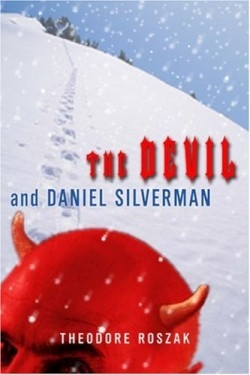The Devil and Daniel Silverman
The line between faith and sadism is explored in this comic novel about a gay writer from San Francisco who accepts a speaking engagement as a “Jewish humanist” at a Bible college in Minnesota. When a snowstorm traps him there, Daniel Silverman finds himself defending not only his values but his life.
There’s no middle ground between Silverman’s world view and that of his hosts; when Silverman talks about an aunt who survived the Holocaust, his hosts ask him if he believes people came from monkeys. A man holds up a picture of an aborted fetus and tells him it’s a picture of the real holocaust.
Silverman is labeled a sodomite; when he cuts himself and bleeds the local doctor declares him a public health risk and quarantines him in his room. At night he hears voices arguing about whether he should be killed.
The author is a professor of history at the University of California, Hayward. His eighteen books include the best-selling The Making of a Counter Culture. He won The James Tiptree Award for “literature that expands our understanding of gender.”
In the thematic climax of this novel, a Professor Oxenstern, a close cousin to the Grand Inquisitor, takes Silverman to his basement lair to show him his collection of what might be called the art of Hell: images of degradation and sexual torment. “If faith is going to touch the heart, there has to be fear, fear of damnation, fear of everlasting anguish, fear of the devil’s cunning,” Oxenstern explains.
Students at the fictional college are required to study those images, he continues: “We want them to know the cost of disbelief. We want them to tremble with uncertainty, wondering if their faith is strong enough to save them from eternal retribution.”
The tension is relieved by moments of farce. Alone in his room, Silverman wraps himself in a sheet and leaps around, imagining himself a grim angel of retribution bludgeoning the cruel matriarch of the college. “There’s Rapture for thee, thou vicious dried up old bitch!” he cries.
The dénouement, parts of which resemble the literary equivalent of a smiley face, is not up to par with the rest of the novel. Given the strength of the whole, it is a flaw that can be overlooked.
Roszak’s portrayal of the Christians is a caricature, but he does, so to speak, give the devil its due. When he debates with his hosts, Silverman finds himself at a loss. They seem to score more. Their reasoning is vaguely circular, and they can resort to a higher authority, while the humanist must struggle alone.
Reviewed by
Rich Wertz
Disclosure: This article is not an endorsement, but a review. The publisher of this book provided free copies of the book to have their book reviewed by a professional reviewer. No fee was paid by the publisher for this review. Foreword Reviews only recommends books that we love. Foreword Magazine, Inc. is disclosing this in accordance with the Federal Trade Commission’s 16 CFR, Part 255.

